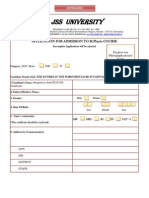Activities Key - Part One
Uploaded by
Kaylea NotarthomasActivities Key - Part One
Uploaded by
Kaylea NotarthomasActivities and Homework Snapshot: Introduction to Environmental Public Health
Provided below is a list of all in-class activities, discussion, and homework ideas for the Introduction to Environmental Public Health lecture. Activities and homework are optional. You may also choose to assign in-class activities as homework if time isnt available to complete them in class or if you prefer them to the provided homework ideas. ACTIVITY 1: Research Your Disease (Slide 10)
What is known or being studied about the environments connection?
NOTE FOR INSTRUCTOR: Assign students a disease and give them ten minutes to research it online and report back to the class on what is known or being studied about the environments connection to the condition. Consider assigning health conditions represented on the Tracking Network.
ACTIVITY 2: Public Health Surveillance (Slide 20)
Research a public heath surveillance system and report back to the class. o Provide an overview of the system. o What data does it provide? o What are the data sources? How are they collected? o What is the value to public health? How are the data used?
NOTE FOR INSTRUCTOR: Give students ten minutes to research online and report back to the class on a public health surveillance system, answering the questions above.
ACTIVITY 3: Environment and Health Laws (Slide 27)
Find another federal environment or health data law and share it with the class.
NOTE FOR INSTRUCTOR: Give students ten minutes to research online and report back to the class.
DISCUSSION: Environmental Health in the News (Slide 30)
Evaluate how environmental public health is reported in the media: o Have any of you read anything lately about how the environment may be affecting public health? o What was the environmental hazard and exposure? o What was the health impact? o Who are the sources for information? o Was the link between hazard and health condition reported as fact?
NOTE FOR INSTRUCTOR: Scan headlines and pull a recent article reporting on environmental public health (perhaps in your state) to help make the connection and drive a discussion with students about the study of environmental public health and how it is used and interpreted in the real world. Have students read article. DISCUSSION PROBES: Is the article balanced? Accurate? What are the sources? Does it create public concern? Does science prove or suggest the link between hazard and health effect? Or, ask some students to respond to the article as a member of the public might, and others to respond as a public health professional might, when first hearing about the issue. Then start a conversation about framing, how issues become politicized, what professionals need to know about the publics typical use of media, public reactions to health-related news, and how that all plays in to public healths goal to solve issues through individual behavior change, stronger regulatory policies, etc. ARTICLE IDEAS: http://www.scientificamerican.com/article.cfm?id=environment-and-ourhealth&WT.mc_id=SA_syn_huffpo http://www.environmentalhealthnews.org/
HOMEWORK 1: Whats Your Issue?
Choose an environmental public health issue you care about. Research and read one recent news or journal article about a study related to this issue. Oral assignment: Summarize article, why is it important to know about this topic, and its impact on public health. Writing assignment: three to four paragraph summary with analysis
HOMEWORK 2: What Does Science Tell Us About Cr-6?
Research studies and articles in journals and the news media throughout recent years and write an executive summary about your findings. Include data and evidence when possible. Questions to consider: o How are individuals exposed to the hazard? o Is human exposure being monitored? In what ways? o Are there any population characteristics to consider? o What is the data source? o Have the data been used to protect public health? If so, how? o Have federal, state, or local laws been enacted as a result of data linking Cr-6 to health issues? o Are there any surveillance systems with data on Cr-6? o What do we not yet know about Cr-6?
You might also like
- Environmental Health From Global to Local (Public Health/Environmental Health), 3rd Edition full download100% (18)Environmental Health From Global to Local (Public Health/Environmental Health), 3rd Edition full download16 pages
- Preliminary For Schools Reading Candidate Answer Sheet: Instructions For Parts 1, 2, 3, 4 and 5100% (2)Preliminary For Schools Reading Candidate Answer Sheet: Instructions For Parts 1, 2, 3, 4 and 52 pages
- Artificial Intelligence in Healthcare: Unlocking its PotentialFrom EverandArtificial Intelligence in Healthcare: Unlocking its PotentialNo ratings yet
- Essays & Term Papers: QuickStudy Laminated Reference GuideFrom EverandEssays & Term Papers: QuickStudy Laminated Reference GuideNo ratings yet
- An Introduction to Lifestyle Management: Participant’s WorkbookFrom EverandAn Introduction to Lifestyle Management: Participant’s WorkbookNo ratings yet
- Social Solutions for Climate Change: How to inspire action through social mediaFrom EverandSocial Solutions for Climate Change: How to inspire action through social mediaNo ratings yet
- PUBH 3136A - Principles of Environmental HealthNo ratings yetPUBH 3136A - Principles of Environmental Health13 pages
- (eBook PDF) Understanding Environmental Health: How We Live in the World 2nd Edition All Chapters Instant Download100% (10)(eBook PDF) Understanding Environmental Health: How We Live in the World 2nd Edition All Chapters Instant Download27 pages
- (Ebook PDF) Understanding Environmental Health: How We Live in The World 2nd Edition 2024 Scribd Download100% (3)(Ebook PDF) Understanding Environmental Health: How We Live in The World 2nd Edition 2024 Scribd Download51 pages
- Download Full (eBook PDF) Understanding Environmental Health: How We Live in the World 2nd Edition PDF All Chapters100% (3)Download Full (eBook PDF) Understanding Environmental Health: How We Live in the World 2nd Edition PDF All Chapters51 pages
- (eBook PDF) Understanding Environmental Health: How We Live in the World 2nd Editioninstant downloadNo ratings yet(eBook PDF) Understanding Environmental Health: How We Live in the World 2nd Editioninstant download28 pages
- Assignment Guidance Sustainability Global and Public Health Draft TwoNo ratings yetAssignment Guidance Sustainability Global and Public Health Draft Two5 pages
- Mastering Mindfulness-Based Stress Reduction: A Science-Backed Guide for Health Professionals: Applying Research and Real-World Strategies for Mindfulness-Based InterventionsFrom EverandMastering Mindfulness-Based Stress Reduction: A Science-Backed Guide for Health Professionals: Applying Research and Real-World Strategies for Mindfulness-Based InterventionsNo ratings yet
- Participatory Action Research for Evidence-driven Community DevelopmentFrom EverandParticipatory Action Research for Evidence-driven Community DevelopmentNo ratings yet
- Failing in the Field: What We Can Learn When Field Research Goes WrongFrom EverandFailing in the Field: What We Can Learn When Field Research Goes WrongNo ratings yet
- Intro To Public Health Discussion ModulesNo ratings yetIntro To Public Health Discussion Modules2 pages
- Ethics, Qualitative And Quantitative Methods In Public Health ResearchFrom EverandEthics, Qualitative And Quantitative Methods In Public Health ResearchNo ratings yet
- Public Health Assignment Lloyd Munkombwe.No ratings yetPublic Health Assignment Lloyd Munkombwe.9 pages
- An Introduction to Lifestyle Management:: Facilitator’s HandbookFrom EverandAn Introduction to Lifestyle Management:: Facilitator’s HandbookNo ratings yet
- Communicating Science and Managing the Coronavirus PandemicFrom EverandCommunicating Science and Managing the Coronavirus PandemicNo ratings yet
- Environmental Governance Reconsidered, second edition: Challenges, Choices, and OpportunitiesFrom EverandEnvironmental Governance Reconsidered, second edition: Challenges, Choices, and OpportunitiesNo ratings yet
- Doing Global Science: A Guide to Responsible Conduct in the Global Research EnterpriseFrom EverandDoing Global Science: A Guide to Responsible Conduct in the Global Research EnterpriseNo ratings yet
- Social Influence Strategies for Environmental Behavior Change: Second EditionFrom EverandSocial Influence Strategies for Environmental Behavior Change: Second EditionNo ratings yet
- EH2001 L01 Introduction To The Course and Main Terms in EHNo ratings yetEH2001 L01 Introduction To The Course and Main Terms in EH23 pages
- The Quality Cure: How Focusing on Health Care Quality Can Save Your Life and Lower Spending TooFrom EverandThe Quality Cure: How Focusing on Health Care Quality Can Save Your Life and Lower Spending TooNo ratings yet
- St. Joseph Academy San Jose, Batangas First Quarter S.Y. 2018 - 2019 Diary Curriculum Map in in Health IxNo ratings yetSt. Joseph Academy San Jose, Batangas First Quarter S.Y. 2018 - 2019 Diary Curriculum Map in in Health Ix5 pages
- Ebooks File Environmental Health Literacy Symma Finn All Chapters100% (3)Ebooks File Environmental Health Literacy Symma Finn All Chapters62 pages
- Building Healthy Community Environments: A Public Health ApproachNo ratings yetBuilding Healthy Community Environments: A Public Health Approach9 pages
- Sustainable Business and Industry: Designing and Operating for Social and Environmental ResponsibilityFrom EverandSustainable Business and Industry: Designing and Operating for Social and Environmental ResponsibilityNo ratings yet
- Environmental Health: Author: Partha Das Sharma, (E.mail:) Website100% (3)Environmental Health: Author: Partha Das Sharma, (E.mail:) Website30 pages
- Environmental Health Literacy Symma Finn - The full ebook version is ready for instant download100% (2)Environmental Health Literacy Symma Finn - The full ebook version is ready for instant download68 pages
- Copia de 1000 Preguntas de Autoevaluacion PDF75% (8)Copia de 1000 Preguntas de Autoevaluacion PDF658 pages
- Chapter 9 Collecting Primary Data Using Questionnaire EditedNo ratings yetChapter 9 Collecting Primary Data Using Questionnaire Edited20 pages
- IBPS Specialist Officer Reasoning Past Exam PaperNo ratings yetIBPS Specialist Officer Reasoning Past Exam Paper3 pages
- HALL TICKET FOR SUMMER 2025 of 2215600165No ratings yetHALL TICKET FOR SUMMER 2025 of 22156001651 page
- Garcia College of Technology Kalibo, Aklan Electrical Engineering DepartmentNo ratings yetGarcia College of Technology Kalibo, Aklan Electrical Engineering Department7 pages
- Behaviours Learned Through Classical ConditioningNo ratings yetBehaviours Learned Through Classical Conditioning6 pages
- Effectiveness of Conventional Lectures Compared To Oral Presentations Prepared by StudentsNo ratings yetEffectiveness of Conventional Lectures Compared To Oral Presentations Prepared by Students18 pages






























































































